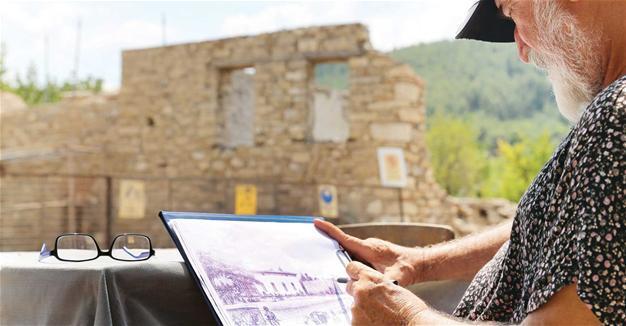Drawings revive Stratonikeia ancient city in western Turkey
MUĞLA
 Findings unearthed at the ancient city of Stratonikeia in the southwestern province of Muğla, as well as the structures to be restored there, are being revived through special drawings made by an excavation painter.
Findings unearthed at the ancient city of Stratonikeia in the southwestern province of Muğla, as well as the structures to be restored there, are being revived through special drawings made by an excavation painter.Stratonikeia, located in Muğla’s Yatağan district, was home to many civilizations throughout its history and is on the UNESCO World Heritage Temporary List as one of the largest marble cities in the world. Excavations have been continuing there since 1977.
Aydın Erkuş, who is working as an excavation painter in the ancient city, said he has also been working on the restoration of old Greek and Ottoman residences in Istanbul’s Beyoğlu district. Among his work in Istanbul is the restoration of the Osman Hamdi Bey Mansion back in 2007, and since then he has been working on architectural restoration projects as an excavation painter.
“It is as if you are living in the past when making these drawings and listening to these stories. I feel like I’m travelling in history. It’s very enjoyable and exciting,” Erkuş said.
“In Stratonikeia I make reconstruction drawings and contribute to the restoration process. I work to complete the restoration projects of the structures and give attention to all details,” he added.
Erkuş said he had made the drawings of the historic bath and the houses that have been unearthed during excavations, as well as the Şaban Ağa Mosgue and the Ottoman-era stone roads. These drawings are also used in academic publications and presentations.
Giving life to structures
Before creating the drawings, Erkuş examines photos of the old structures and the head of the excavations gives him information about the period of the structures.
Visitors to the region get information about the structures and the life of the ancient city thanks to the drawings of various parts of the ancient city, he said.
“I have so far made nearly 800 drawings, including the surface surveys in the ancient cities of Stratonikeia and Lagina. I’ve also created around 600 figures to be used in the future in Stratonikeia,” Erkuş said.
The head of the Stratonikeia excavations, Professor Bilal Söğüt, said the city had been home to many civilizations including the Hellenistic, Roman, Byzantine, Anatolian beylics, Ottoman and Republican eras.
Notable pieces were during excavation and restoration works every year in the city, Söğüt added.
“Our excavation painter makes the drawings of these structures and visitors have the chance to see them in their original state thanks to these drawings,” he said.
Since 1977
Stratonikeia, a city in the interior of Caria, is located in the present-day village of Eskihisar. The first scientific excavations at the site began in 1977 under the direction of Professor Yusuf Boysal. Söğüt has been carrying out research, excavations and restoration work at the site since 2008.
The structures discovered in the city include fortification walls, a city gate with its monumental fountain, a colonnaded street, a gymnasium, a bouleuterion, a bath, a theater, a temple and a water structure. In addition, a bath from the Emirates Period (14th-15th century A.D.), a mosque from the 19th and the 20th centuries, a coffeehouse and a number of dwellings, streets, shops and fountains can be found there.
















